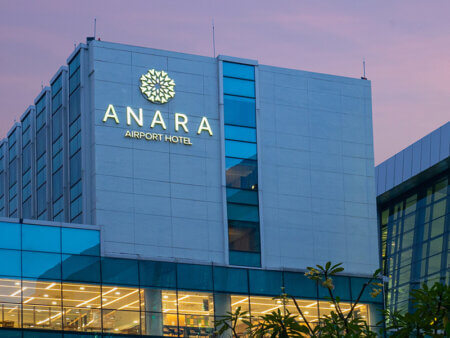Snorkeling the Reefs of Ambon and Raja Ampat!
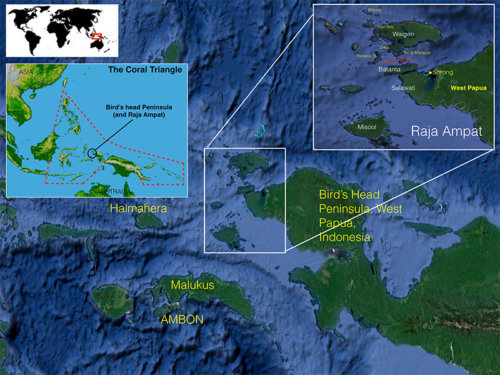 Ambon is part of the Maluku Islands, made famous by nutmeg and mace, highly sought-after spices during the 16th and 17th centuries. Advances in spice cultivation in the latter parts of the 17th century took the spotlight off of the Malukus and they quietly retreated back into obscurity. Though sleepy and off-the-beaten-path, the islands reside squarely within the coral triangle and are now known for their incredible coral reefs. Decades if not centuries of isolation allowed for amazing reef growth and the astonishing number of fishes and invertebrates that comes with it.
Ambon is part of the Maluku Islands, made famous by nutmeg and mace, highly sought-after spices during the 16th and 17th centuries. Advances in spice cultivation in the latter parts of the 17th century took the spotlight off of the Malukus and they quietly retreated back into obscurity. Though sleepy and off-the-beaten-path, the islands reside squarely within the coral triangle and are now known for their incredible coral reefs. Decades if not centuries of isolation allowed for amazing reef growth and the astonishing number of fishes and invertebrates that comes with it.x
Conversely, Raja Ampat needs no introduction. Known the world over for its incredible marine biodiversity and variety of shallow water habitats, Raja Ampat remains an exceptional destination for snorkelers who want experience what a healthy, robust coral reef looks and feels like. This special departure gives us the chance to combine these two remarkable destinations where we can explore a bit of Ambon before heading to snorkel the amazing reefs of Misool and Dampier Strait in Raja Ampat.
ITINERARY
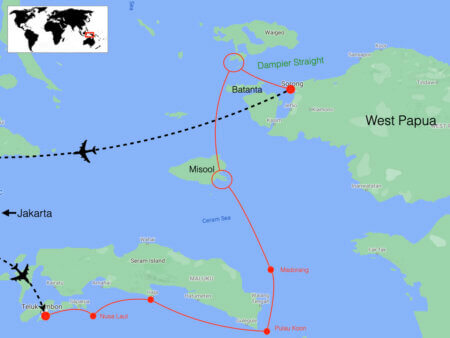 Our snorkeling tour begins and ends in Jakarta, Indonesia. One round trip, internal flight (Jakarta-Ambon; Sorong-Jakarta). Upon our arrival in Ambon, we will board our boat and begin our cruise towards Sorong. Please note that although we visit many of the islands and island groups in the sample itinerary below, each of our departures is unique and that weather, tides, and opportunities to explore all play a role in the decisions about our daily schedule as well as the overall itinerary.
Our snorkeling tour begins and ends in Jakarta, Indonesia. One round trip, internal flight (Jakarta-Ambon; Sorong-Jakarta). Upon our arrival in Ambon, we will board our boat and begin our cruise towards Sorong. Please note that although we visit many of the islands and island groups in the sample itinerary below, each of our departures is unique and that weather, tides, and opportunities to explore all play a role in the decisions about our daily schedule as well as the overall itinerary.
Day 1: Jakarta / Anara Airport Hotel Jakarta
Meals provided: D
Meet in Jakarta, Indonesia at our group hotel, the Anara Airport Hotel, for the tour orientation and welcome dinner. As is often the case with our internal flight, we will depart for Sorong in the late evening, thus our ‘overnight’ will be in transit to Sorong. Overnight Anara Airport Hotel Jakarta.
Day 2: Ambon / Laha
Meals provided: B,L,D
Fly to Ambon and transfer to our live-aboard boat. If time permits, we’ll have the chance to snorkel at Laha where rare and bizarre critters like frogfishes, dragnets, and juvenile sweetlips can be found in very shallow water. After dinner, depart for Nusa Laut. Overnight:
Day 3: Nusa Laut
Meals provided: B,L,D
Nusa Laut is located along the southwest region of Ceram. The reefs around the island range from steep exposed walls to shallow protected reef flats. Along south-facing seaward reefs schools of colorful fish flow over healthy stands of coral that grow in abundance around the reef margin. In protected lagoons, black sand creates a contrasting backdrop to the bright corals and fish in shallow water. Overnight:
Day 3: Haya / SE Ceram
Meals provided: B,L,D
Haya is home to a wonderful shallow reef that boasts a high diversity of robust coral that display massive and columnar formations. The high number of branching corals promotes a high diversity of butterflyfish and other reef fish that associate with the important habitat. Along the southeastern coast of Ceram, dramatic landscape fronts black sand seascapes that are perfect for critter-hunting. Overnight:
Day 5: Pulau Koon / Madorang
Meals provided: B,L,D
Pulau Koon is part of an extensive reef system that comprises several of the islands nearby. Good water movement brings nutrient-rich water along the steep reefs that attracts large and diverse schools of fish as well as provides food for the lush assemblage of coral . Madorang is an amazing little islet encapsulated by a near-perfect circular reef. Thousands of anthias in clear-blue water glitter in the light above the shallow reef margin while larger fish like Napoleon wrasse, big-eye jacks, and coral groupers roam along the steep drop-offs. This island is usually a fan favorite and often rated as one of the best snorkels along the trip. Overnight:
Day 6: Misool, Raja Ampat / Wayil / Segaf
Meals provided: B,L,D
The islands of Misool are the remnants of an ancient reef that jutted out Misool into the Arafuru Sea. Plate tectonics caused the uplift and rain, wind, and seawater further eroded the limestone into the network of islands we see today. The reefs in the area are even more spectacular than the limestone islands they grow upon. We’ll spend our first day visiting Wayil where wide channels between islands create an amazing habitat for large fish and corals such as sea fans. We’ll also have the chance to explore a reef that possess a variety of habitats including micro-atolls (massive coral colonies that grow outward rather than upward toward the surface), and fields of stag horn coral. Overnight:
Day 7: Misool / Len Kafal
Meals provided: B,L,D
The limestone islands closer to Misool are a series of small island groups that create maze of hidden lagoons, narrow passes, and marine lakes. We’ll take advantage of these habitats and snorkel a narrow channel that is covered with soft corals and sea fans, and with a bit of patience quite a few species of nudibranchs. We’ll also snorkel in a protected lagoon created by a network of stunning limestone cliffs. This area is perfect for using our dinghies to cruise through some of the amazing island groups that exist in this area. Overnight:
Day 8: Misool / Balbulol / Farondi
Meals provided: B,L,D
Some of the most scenic islands in Misool are on tap for the day. Both Balbulol and Farondi have large, deep, protected bays with reefs that fringe from steep limestone cliffs and plunge steeply for hundreds of feet. Protection from wind and strong currents attract a variety of juvenile fish, as well as create a superbly serene snorkeling environment. Overnight:
Day 9: Batanta
Meals provided: B,L,D
Our snorkel sites on Batanta Island is in semi-protected bay / passage that harbors one of the healthiest hard coral gardens in all of Raja Ampat. From massive boulder corals to colorful table corals, just about every shape and color are represented here. The hard corals also attract a huge number and diversity of reef fishes, making this site a real-life aquarium! We may also have the chance to snorkel with manta rays as they often visit the bay during strong tides to feed. Overnight:
Day 10: Fam Islands / Penemu
Meals provided: B,L,D
A few hours to the north lies the Fam Island group and the largest, most popular of them, Penemu Island. The reefs around Penemu are amazing examples of steep coral-encrusted walls that begin just a few feet from shore. Our first site is exactly this plus larger species of fish such as unicornfishes and snappers are common and if we drift over to the other side of the point, expect to see blacktip sharks! In the afternoon, we visit a secluded lagoon where fields of delicate staghorn corals can be found. The Fam group is made of uplifted high limestone islands and on Penemu we have the chance to walk stairs to the top of one of the islands for magnificent panoramic views. Overnight:
Day 11: Pef / Yangeffo
Meals provided: B,L,D
Pef is a small group of islands that lies just off the northern tip of Gam and Yangeffo is a grouping of mangrove islands located off the western tip of Gam. Waters around mangrove islands are usually turbid and without many corals, but Pef and Yangeffo benefit from their proximity to Dampier Strait. Clear, blue seawater circulates around the islands, promoting the growth of coral reefs right up to, and often on top of, mangrove roots that grow along the shoreline. Few other places in the world can offer healthy, robust mangrove stands footed by lush coral reef! Overnight:
Day 12: Friwinbonda
Meals provided: B,L,D
The island of Friwinbonda is nearly encircled by an enormous reef with steep walls on one side of the island and a shallow, exposed reef flat on the other. The steep walls are adorned with red, orange, and yellow sea fans and the deep indentation along the island allows us to explore the sub-tidal zone where we can see nudibranchs and snails. The reef flats are a popular spot for cuttlefish and we’ll look for the Raja epaulette shark under the enormous sheets of encrusting soft corals! Overnight:
Day 13: Sorong / Jakarta / Anara Airport Hotel
Meals provided: B, D
Disembark for our connection to Jakarta. Check in and farewell dinner at the group hotel in Jakarta. Overnight Anara Airport Hotel, Jakarta.
Day 14: International flights or extensions
Meals provided: B
DEPARTURES
Nov 2026 ←Click to request a booking
Tour cost includes:
- Accommodations throughout tour dates
- All meals on days 2 through 13 (dinner on day 1 – breakfast on day 14)
- All internal transfers including international arrival and departure transfers
- Non-alcoholic beverages
- All snorkeling and park fees
- All gratuities
Tour cost does not include:
- Round-trip international airfare
- Additional hotel accommodations and meals as a result of travel outside of the program dates
- Visa requirements including payments
- Alcoholic beverages
- International departure taxes
- Extra / overweight baggage fees
- Trip insurance (recommended; (we recommend Travel Guard, World Nomads, or Travel Insure)
- DAN insurance (required unless personal insurance program has worldwide emergency evacuation services)
- Additional accommodations while on tour in the event of flight schedule changes or events of force majeure
- Fuel surcharges (if applicable)
Cancellation policy:
180 – 91 days prior to departure: 50% of trip cost
90 days or less prior to departure: 100% of tour cost
Please see our Terms and Conditions
Accommodations
We have not yet chartered a boat for this departure. Given the points of embarkment and disembrakment for the boat, we will probably begin and then the tour in Jakarta
ANARA AIRPORT HOTEL
Anara Airport Hotel is the only integrated hotel with Terminal 3 International Airport Soekarno-Hatta. Deluxe rooms include flatscreen TV with cable and satellite, work desk, hair dryer, mini cooler, and coffee/tea maker. Explore authentic Asian and delightful international cuisines at the Selasih restaurant or relax in the ambiance of the Lobby Lounge. Onsite facilities include a wellness spa and gym and four functional/meeting rooms. Easy access from the airport Combined with the elegance of a modern hotel makes Anara the perfect choice for business and leisure travelers. More photos
WHAT TO EXPECT
Ambon and Raja Ampat are located south of the Equator. Weather year round is hot and humid, with nearly daily rain showers occurring in the early morning or late afternoon. Daytime temperatures hover around 86º F (30º C) and do not fall much at night. Water temperatures average around 82º F (28º C), though cooler temperatures may occur if persistent rains cause a thin layer of cool freshwater on the surface. Currents around the islands of Raja Ampat may be strong at times. While we plan our snorkel session around the slack tides, we also have several sites where having water movement is an advantage. These drift snorkels allow us to cover large tracts of reef without having to swim too hard. Our snorkel sessions are 100% boat supported and two dinghies will be there at all times to assist anyone for whatever reason.
We will have the chance to climb staircases for panoramic views on Penemu. For this, all that is needed is loose fitting clothes and foot protection that can get wet (e.g., sandals or neoprene booties). Our summit walk is simply climbing a series of sturdy wooden stairs.
Please read more about our daily schedule.
WHAT TO BRING
The following list is a suggestion of things to bring and applies to almost all our trips. Specific items on a particular departure will be noted on the departure information.
-A good fitting mask, snorkel, and set of fins. If your equipment is brand new, please try it out in the pool. Determining the fit and function of your equipment in the pool includes doing several laps with all your equipment on. Doing several snorkel dives is also very beneficial. It is also important to clean your new equipment, especially your mask. Cleaning procedures for your mask include light scrubbing with toothpaste or dishwasher soap to remove the layer of silicon used to preserve the mask during shipping. Clean both sides of the mask. Doing this greatly reduces the chances of having your mask fog. Not doing this, even when using mask de-fogger, usually results in a fogged mask.
-A wetsuit, rash guard, diveskin, or any type of clothing that can be used for thermal and/or protection from the sun. We suggest bringing a full 3mm wetsuit and some type of core insulation like a vest or shirt made of 1 – 2 mm neoprene (e.g., Lavacore or Sharkskin shirts or vests). These items will not only provide thermal protection but protection from the sun as well. For those who feel that a 3mm suit may be too warm, please consider a full body skin or rash guard to ensure protection from the sun. With regards to thermal protection, remember the saying: It is better to have and not need, than to need and not have. One that note…
-Head protection in the form of a wetsuit hood, a cap, or even a bandana. Anything that can keep the sun off your head is extremely important. It is the most exposed part of our bodies when we are floating on the surface.
-Underwater flashlight on departures with a planned night snorkel
-Biodegradable sunscreen lotion. Sunscreen lotions can be harmful and even kill tiny larvae (baby marine life). It is fine to wear on land, but we highly discourage the use of sunscreen lotions in the water. A full wetsuit or dive skin will protect one from the sun much better than lotions and provide thermal protection. It is truly a win-win for everyone and the marine environment.
-Casual, lightweight, tropical clothing
-Sunglasses (and a spare in case you lose your main pair)
-Comfortable footwear such as active sandals (Teva, Keen, Merrell, etc.)
-Hats. We cannot stress the importance of a hat in the tropics!
-All our boats provide items like shampoo, soap, towels, etc. We bring this up because these items represent added weight or may leak.
Other items to consider:
-Lightweight rainwear to protect from the occasional afternoon shower
-Binoculars
TRIP REPORTS
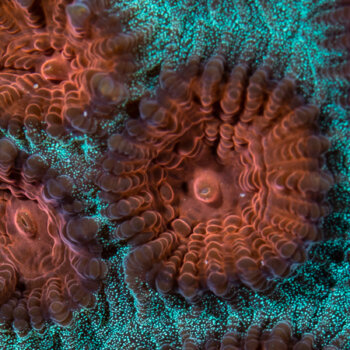
Raja Ampat trip report March 2023
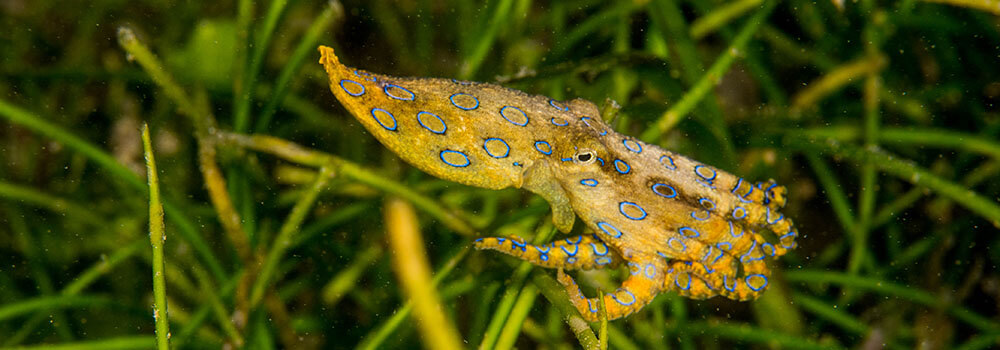
Banda Islands Trip Report, Nov 2017

Something fishy is going on in Eastern Indonesia
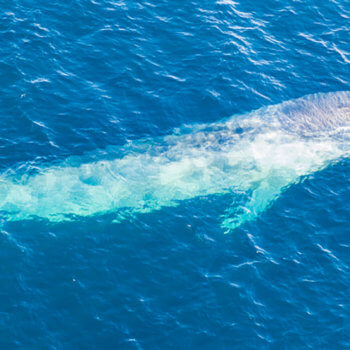
Heart of the Coral Triangle Trip Report

Flying High in the Coral Triangle



